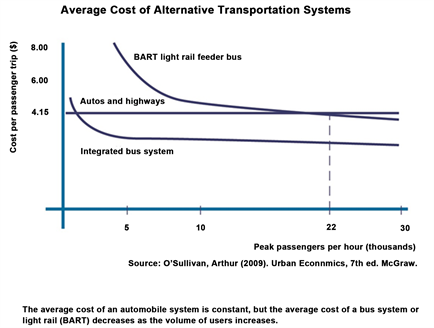Example 8. Market failures, urban transportation, and path dependency.
The example represented in this chart shows the possibility that beneficial long term mass transit options won’t be part of growing cities or urban communities, because the economics so favor cars and busses at early stages (until reaching a critical threshold of ridership). Why don’t markets quickly embed these time horizons and present profitable opportunities for investment (now) and profitable revenue streams (in the future)? Part of the answer may be the lack of full financial intermediation in sustainability markets and products compared to more traditional financial products and services markets. Nevertheless, and for purposes here, this can be categorized as a market failure.

In this example, without government support, or other ideas for addressing the missing pillar of early economic feasibility of more efficient and sustainable transport options, we risk following the least best transport option. In fact, this can become an expensive problem to reverse later if we wanted to switch transport options after investing heavily in another choice. Clearly, the connection between society’s sustainability goals and setting our priority research agendas is important here, based first upon the primary goal of achieving sustainable development at scale and speed, and based upon approaches like the three pillars framework to help us identify critical break points or opportunities.
This is also a perfect example, however, of needing as much design work as we need planning, in the sense that over-planning is also a risk compared to a more flexible (and update-oriented) structure. The same path dependency just mentioned that can lead to lock-in to suboptimal vehicle transport choices compared to mass transit options, can operate in other ways.
For example, we can also be locked-in to technology choices that were right at the time they were first considered, but become poor choices as other sustainability and development issues begin to bind or become relevant. The three pillars model to address sustainable development challenges speaks as much to flexible (but supported) approaches as to specific project implementations. Consider, for example, an extension of the basic transportation question:
“Apart from optimizing the present system, however, we know that the total system, as well as the individual transport modalities, are directly connected to hard constraints related to sustainability, such as land use, energy security, and pollution, as well as to other trade-offs that inevitably must be made when the future transportation system is shaped. And policies driven only by technological advancement often lead to problems if the interconnections with social, economic, and governance issues are not taken into account.
Suppose the decision is made to introduce electric vehicles to decrease local pollution, dependence on oil, and carbon dioxide emissions. Such a decision comes with a commitment to promote the vehicle modality (as opposed, perhaps, to shifting to mass transit), which in turn is a commitment to the related creation and maintenance of road infrastructure (which requires land and other resources). Also, it may require a new energy supply, ways to deliver it, and new infrastructure to provide re-charging possibilities.
And these decisions will affect many aspects of social life, such as preferences for housing, need for parking lots (more space), estate development, real-estate pricing, road congestion, commute times, and choices for employment location. In fact, the transportation system is connected to many major aspects of public wellbeing. Consider public health: pollution influences diseases like asthma and childhood pulmonary development issues; traffic jams and long commutes relate to stress and depression; and of increasing importance will be relationships to elder care and ease of access to hospitals [21] .”
In summary, electric vehicles, as well as funding their research and development, may well be a good choice for modern and urban transport solutions, but their deployment is something we must analyze and test in the context of the complex web of other options and ongoing technological relationships. As a final extension of this example, with the development of driverless vehicles we may be reaching a point of new convergence where individual electric cars could become part of chains of (autonomous agent) vehicles operating within a computer-assisted stream of traffic. What started, in other words, as a relatively inefficient automobile transport model, may start to resemble many other mass transit options.